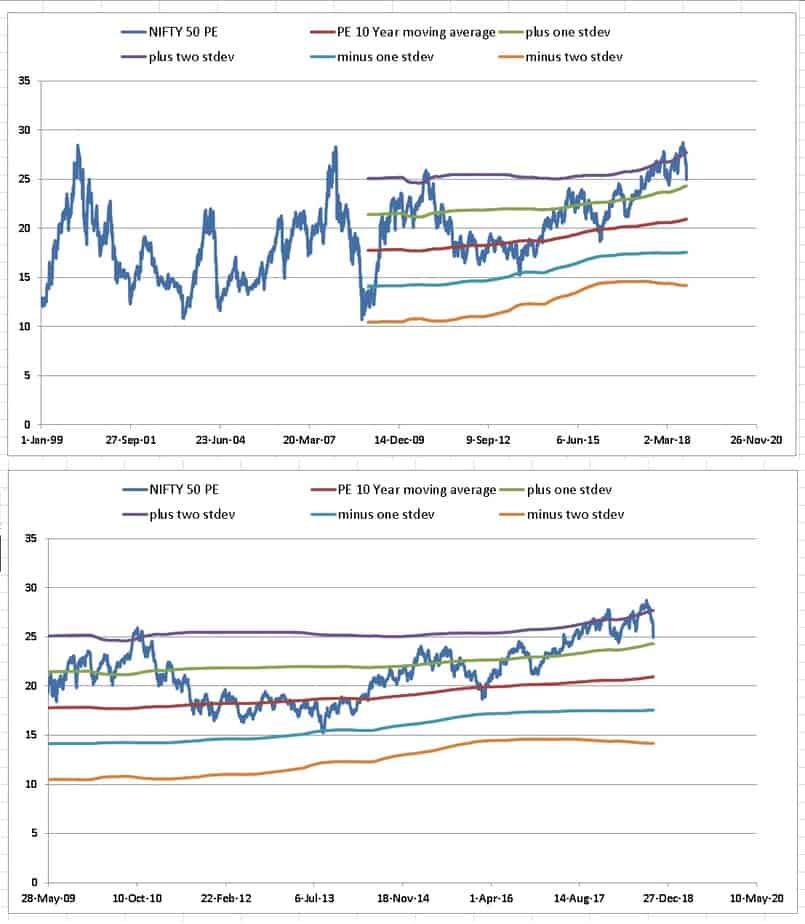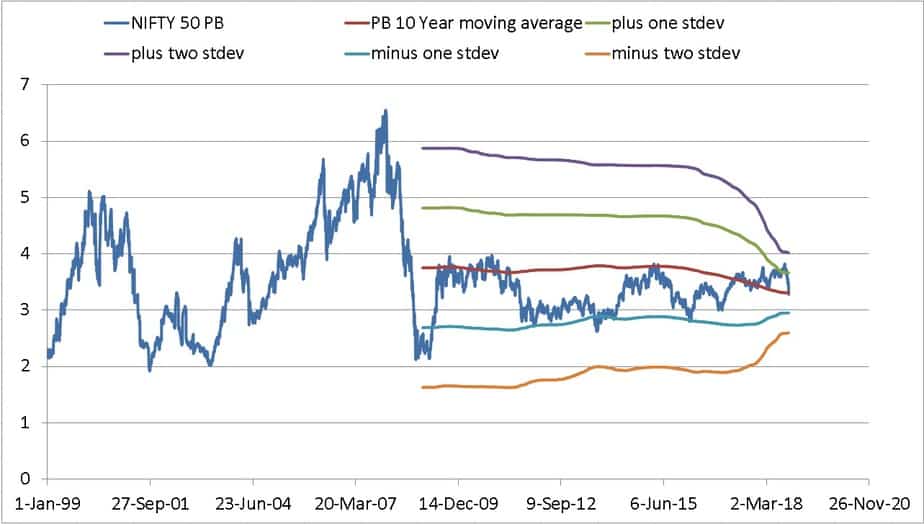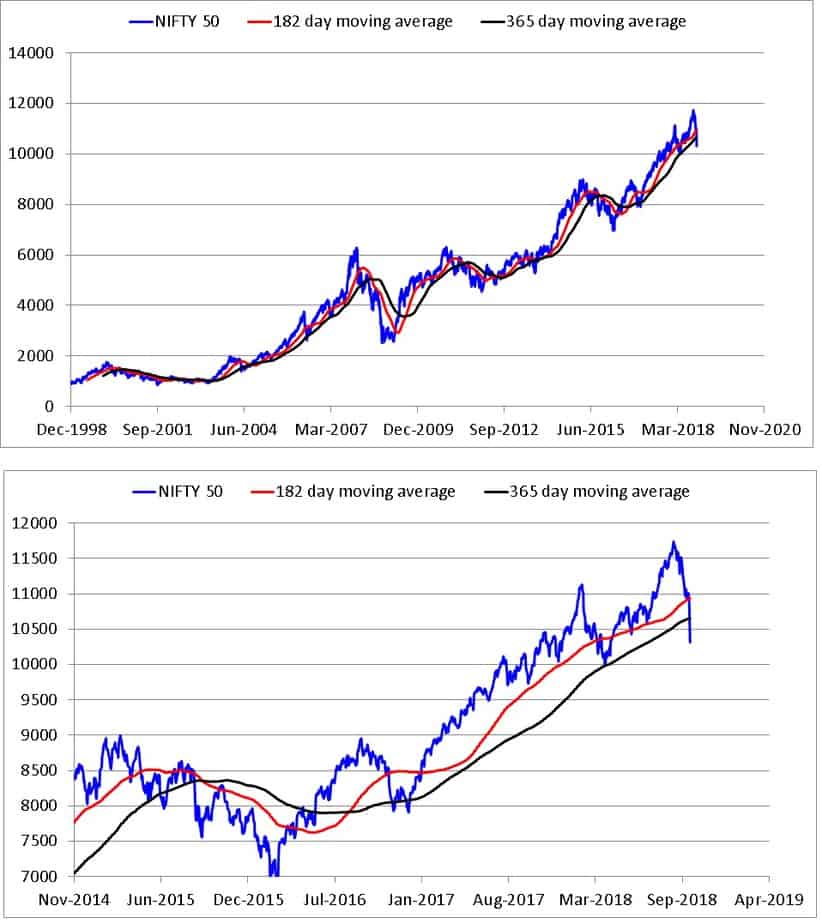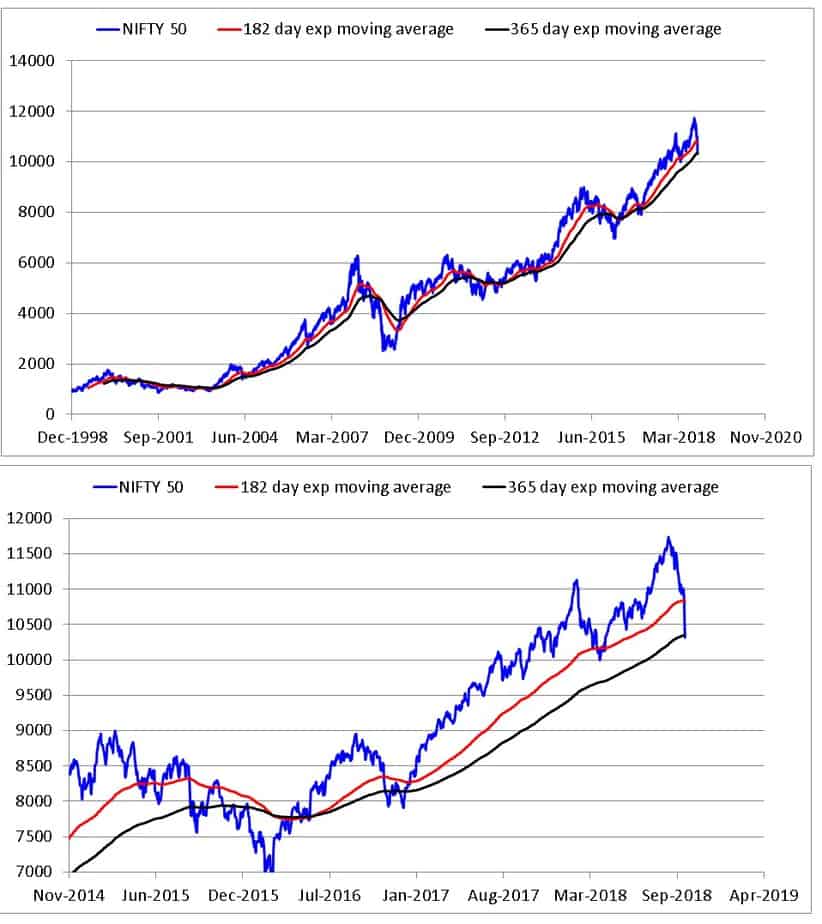Last Updated on December 29, 2021 at 11:54 am
Can we spot market highs and lows using technical indicators? The answer is yes, provided a user understands the pros and cons of each method. I discuss the current state of a few technical indicators and discuss their benefits and limitations. This post is in-part triggered by comments from Dhinesh Kumar here: Timing the market by spotting bullish and bearish trends
Before we begin, if you have missed the last couple of posts, you can catch up right now.
- How should we invest in the present market condition?
- Use this “market crash” to clean up your equity fund portfolio tax free!
- 10 things mutual fund investors should not be doing!
There are several technical indicators available for trading. Smart traders combine many indicators to minimize their losses. Smart traders also understand that in real-time making decisions is far tougher than looking at a chart in hindsight and that things can go wrong.
The problem is that many people who talk about technical analysis act and talk like they know the knows of nature and markets. They sound so sure of themselves, that it is repulsive. It is a blind marriage to the indicators. The situation is similar to many who have a “guruji”. If a cup falls off a table and is not broken because it fell on their feet first, many would claim, “the grace of guruji saved the cup from breaking”. Such is the blind faith and acceptance of technical indicators.
Join 32,000+ readers and get free money management solutions delivered to your inbox! Subscribe to get posts via email! (Link takes you to our email sign-up form)
🔥Want to create a complete financial plan? Learn goal-based investing? Exclusive access to our DIY tools? Increase your income with your skills? Use this link to enjoy massive discounts on our robo-advisory tool & courses! 🔥
I am not saying such indicators do not work, they do, but like everything in life, if you want some the good, you have to live with the bad. The problem is many sound as if there is no bad and the indicators will work “for sure”. The other extreme is the so-called investors (especially those who call themselves value investors) who blindly dismiss technical indicators as nonsense.
What follows is an open-minded approach to the topic. The problem is never with any formula or indicator. The problem is with the humans who use it or rather who fail to use it right. Human emotions and inflexibility cloud the true efficacy of these indicators. That is enough, let us get on with it
The 10-year moving average of the Nifty 50 PE
Readers can plot this and much more with the sheet in Nifty Valuation Analysis with PE, PB, Div Yield, ROE, EPS of 21 NSE Indices. If there is enough interest, I can extend this sheet to include the other indicators discussed today.
The PE ratio is the current price divided by the earnings per share of the index. If the PE is “too high” then the market is paying too high a price for the earnings and must “correct” down (I hate that word now!). If the PE is “too low” then the market is paying too low a price and must correct up.
Have a look at the 10-year moving average (avg) of the Nifty 50 PE (the centre line below). The standard deviation (stdev) tells you how much each Nifty PE value deviates from the average. The two lines above the central average line represent:
- avg + stdev
- avg + 2*stdev
Similarly, the two lines below the central average line represent:
- avg – stdev
- avg – 2*stdev
Now, this imo is the weakest indicator for two reasons. We do not have much data and the average keeps moving with each passing day. The second graph below shows an expanded view on the recent trend.
It is tempting to assume that if the Nifty PE hits the avg + 2*stdev line, it is time to quit equity. However, as you can see, it can move down and move back up quickly. If you go by this indicator, you will have to pull out of equity and stay out for months and months (even ~ 2Y) as seen in Market Timing with Index PE Ratio: Tactical Asset Allocation Backtest Part 1 (this uses high and low values and not moving averages)
IMO, this is neither practical nor reliable as what we call as a high PE is simply too dependent on time: What is a high index PE?. At best it can be used for getting backing into the market, say when Nifty PE is below the moving average (again only a crude indication).
The 10-year moving average of the Nifty 50 PB
Arguments made above can also be used to gauge valuation using the price to book value. The book value or shareholders is a measure of asset assets – liabilities. So it is a bit like the NAV of a ETF and the current market price the price of the ETF.
If we go by the above chart, high valuations could correspond to current PB > the 10Y PB average but notice how sharply the average falls. So I don’t think it is that reliable. Also, read: Is PB-based investing better than PE-based investing?
Simple moving average crossovers
I recently discussed this method here: Timing the market by spotting bullish and bearish trends. The idea is to smoothen the daily market movement using an average. For example, on the 365th day, you take the average of the last 365 closing prices), do the same next day and the next and so on.
If you use a single moving average, then when the market price dips below the moving average it is a sell-signal and vice versa. A more reliable method is to use two moving averages and look for crossovers.
You can use 12-month and 6-month, 10-month and 5-month etc. Results will not differ much. Do not spend time backtesting to find out the perfect combination and call it guruji. That is silly.
You can see one such moving average pair below. When the short-term average falls below the long-term average, it is time to quit. When the short-term average moves above the long-term average it is time to re-enter.
If you take this seriously, then it is not yet time to exit. The trouble with this indicator is that it generates buy and sells signal well after the fall or rise event. Also, there can be crossovers in quick succession resulting in moving in and out too much.
The question we shall consider for the rest of the post is, it is possible to spot market highs and lows a bit earlier than this method.
Exponential moving average crossovers
The standard alternative to the simple moving average (SMA)is the exponential moving average. (EMA) This offers higher weight to recent price movement and responds faster than the simple moving average as seen below. The weight to older data decreases exponentially and hence responds faster. The EMA peak is closer to the market peak than the SMA peak, but there is not much different in the case of the troughs.
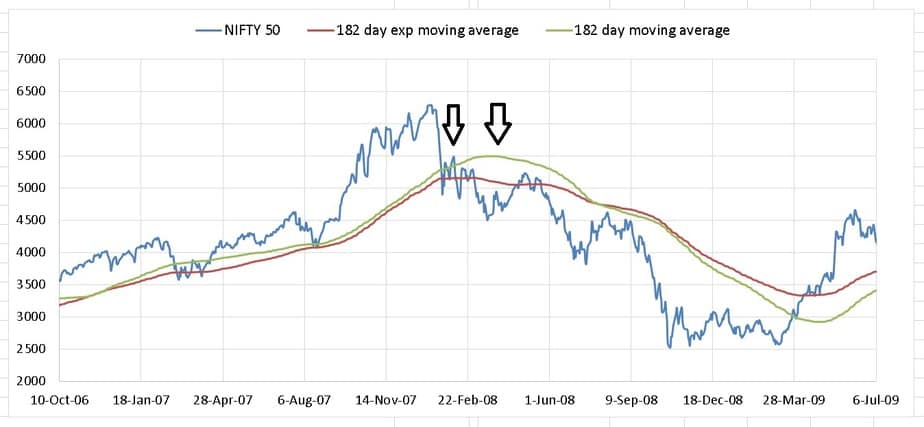 Now have a look at the double EMA crossover.
Now have a look at the double EMA crossover.
The difference between SMA and EMA is not significant for such long-term indicators. This is because the weight offered to recent price data is quite less for such long-term EMAs.
Moving Average Convergence Divergence (MACD)
A potentially more sensitive method is to compute the difference between the two EMAs above and then take the moving average of the difference. The MACD seen below is the difference between the 180-day EMA and 365-day EMA. The average of this difference is known as the MACD signal or simply the signal. I have used a 136-day average. Since these are long-term indicators, the usual trading rules will not apply as-is.
Sell signal: When the MACD goes below its signal.
Buy signal: When the MACD goes above its signal.
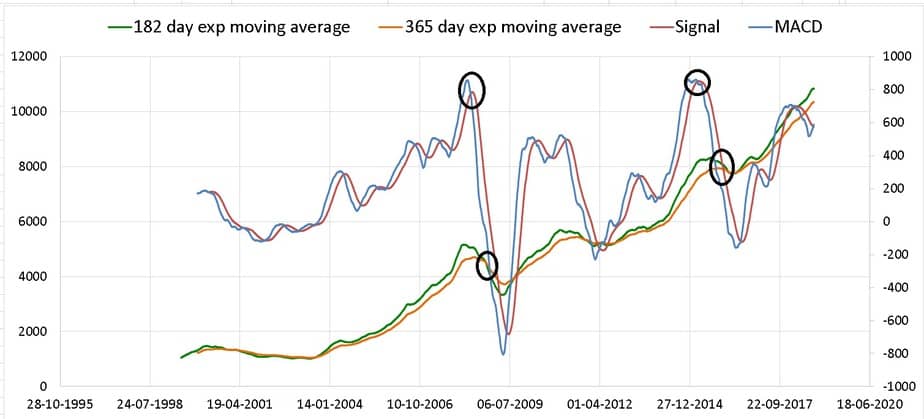 If we compare the MACD+signal with the double EMAs (pic above), notice that the MACD/signal sell signals appear earlier* than the double-EMA sell signal. However, the opposite is true for buy signals. So nothing is perfect! * sometimes months earlier.
If we compare the MACD+signal with the double EMAs (pic above), notice that the MACD/signal sell signals appear earlier* than the double-EMA sell signal. However, the opposite is true for buy signals. So nothing is perfect! * sometimes months earlier.
Notice the current levels of the MACD/signal and recognise that it hard to make calls in real time and very easy to do so while looking at the past. It will take a good amount of courage, conviction and discipline to follow these technical indicators if you are open-minded about them. Perhaps that is why many people use the guruji technique. If we get rid of reason, we can cheer if our guruji says E is not mc^2 and that there is a software to make animals talk.
Relative Strength Index (RSI)
The simplest definition of the RSI is that it represents recent average gains divided by average losses. If the avg gains are higher than the index is overbought. If the avg losses are higher, the index is oversold. The problem with the RSI is similar to that of the PE or PB ratios. It is based on arbitrary high or low numbers. I have plotted the 365-day RSI for the Nifty below.
It is pretty hard to use the RSI for getting out of the market. However, like the PE, a low RSI say 50-ish or lower seems like an indication to buy.
Summary
Each technical indicator has flaws so the only option is to combine them so that we use their best features for buying/selling. For example, the MACD sell signal can be used for exit and low RSI for entry. However, this is easier said than done in real-time. Technical indicator bhakts often refuse to recognise this.
Give this sheet a try: Nifty Valuation Analysis with PE, PB, Div Yield, ROE, EPS of 21 NSE Indices. If there is enough interest, I can extend this sheet to include EMA, MACD and RSI.
Missed the last couple of posts? You can catch up right now.
- How should we invest in the present market condition?
- Use this “market crash” to clean up your equity fund portfolio tax free!
- 10 things mutual fund investors should not be doing!

Use our Robo-advisory Tool to create a complete financial plan! ⇐More than 3,000 investors and advisors use this! Use the discount code: robo25 for a 20% discount. Plan your retirement (early, normal, before, and after), as well as non-recurring financial goals (such as child education) and recurring financial goals (like holidays and appliance purchases). The tool would help anyone aged 18 to 80 plan for their retirement, as well as six other non-recurring financial goals and four recurring financial goals, with a detailed cash flow summary.
🔥You can also avail massive discounts on our courses and the freefincal investor circle! 🔥& join our community of 8000+ users!
Track your mutual funds and stock investments with this Google Sheet!
We also publish monthly equity mutual funds, debt and hybrid mutual funds, index funds, and ETF screeners, as well as momentum and low-volatility stock screeners.
You can follow our articles on Google News

We have over 1,000 videos on YouTube!

Join our WhatsApp Channel



- Do you have a comment about the above article? Reach out to us on Twitter: @freefincal or @pattufreefincal
- Have a question? Subscribe to our newsletter using the form below.
- Hit 'reply' to any email from us! We do not offer personalised investment advice. We can write a detailed article without mentioning your name if you have a generic question.
Join 32,000+ readers and get free money management solutions delivered to your inbox! Subscribe to get posts via email! (Link takes you to our email sign-up form)
About The Author
 Dr M. Pattabiraman (PhD) is the founder, managing editor and primary author of freefincal. He is an associate professor at the Indian Institute of Technology, Madras. He has over 13 years of experience publishing news analysis, research and financial product development. Connect with him via Twitter(X), LinkedIn, or YouTube. Pattabiraman has co-authored three print books: (1) You can be rich too with goal-based investing (CNBC TV18) for DIY investors. (2) Gamechanger for young earners. (3) Chinchu Gets a Superpower! for kids. He has also written seven other free e-books on various money management topics. He is a patron and co-founder of “Fee-only India,” an organisation promoting unbiased, commission-free, AUM-independent investment advice.
Dr M. Pattabiraman (PhD) is the founder, managing editor and primary author of freefincal. He is an associate professor at the Indian Institute of Technology, Madras. He has over 13 years of experience publishing news analysis, research and financial product development. Connect with him via Twitter(X), LinkedIn, or YouTube. Pattabiraman has co-authored three print books: (1) You can be rich too with goal-based investing (CNBC TV18) for DIY investors. (2) Gamechanger for young earners. (3) Chinchu Gets a Superpower! for kids. He has also written seven other free e-books on various money management topics. He is a patron and co-founder of “Fee-only India,” an organisation promoting unbiased, commission-free, AUM-independent investment advice.Our flagship course! Learn to manage your portfolio like a pro to achieve your goals regardless of market conditions! ⇐ More than 3,500 investors and advisors are part of our exclusive community! Get clarity on how to plan for your goals and achieve the necessary corpus no matter the market condition!! Watch the first lecture for free! One-time payment! No recurring fees! Life-long access to videos! Reduce fear, uncertainty and doubt while investing! Learn how to plan for your goals before and after retirement with confidence.
Increase your income by getting people to pay for your skills! ⇐ More than 800 salaried employees, entrepreneurs and financial advisors are part of our exclusive community! Learn how to get people to pay for your skills! Whether you are a professional or small business owner seeking more clients through online visibility, or a salaried individual looking for a side income or passive income, we will show you how to achieve this by showcasing your skills and building a community that trusts and pays you. (watch 1st lecture for free). One-time payment! No recurring fees! Life-long access to videos!
Our book for kids: “Chinchu Gets a Superpower!” is now available!


Must-read book even for adults! This is something that every parent should teach their kids right from their young age. The importance of money management and decision making based on their wants and needs. Very nicely written in simple terms. - Arun.Buy the book: Chinchu gets a superpower for your child!
How to profit from content writing: Our new ebook is for those interested in getting a side income via content writing. It is available at a 50% discount for Rs. 500 only!
Do you want to check if the market is overvalued or undervalued? Use our market valuation tool (it will work with any index!), or get the Tactical Buy/Sell timing tool!
We publish monthly mutual fund screeners and momentum, low-volatility stock screeners.
About freefincal & its content policy. Freefincal is a News Media organisation dedicated to providing original analysis, reports, reviews and insights on mutual funds, stocks, investing, retirement and personal finance developments. We do so without conflict of interest and bias. Follow us on Google News. Freefincal serves more than three million readers a year (5 million page views) with articles based only on factual information and detailed analysis by its authors. All statements made will be verified with credible and knowledgeable sources before publication. Freefincal does not publish paid articles, promotions, PR, satire or opinions without data. All opinions will be inferences backed by verifiable, reproducible evidence/data. Contact Information: To get in touch, please use our contact form. (Sponsored posts or paid collaborations will not be entertained.)
Connect with us on social media
- Twitter @freefincal
- Subscribe to our YouTube Videos
- Posts feed via Feedburner.
Our publications
You Can Be Rich Too with Goal-Based Investing
 Published by CNBC TV18, this book is designed to help you ask the right questions and find the correct answers. Additionally, it comes with nine online calculators, allowing you to create custom solutions tailored to your lifestyle. Get it now.
Published by CNBC TV18, this book is designed to help you ask the right questions and find the correct answers. Additionally, it comes with nine online calculators, allowing you to create custom solutions tailored to your lifestyle. Get it now.Gamechanger: Forget Startups, Join Corporate & Still Live the Rich Life You Want
 This book is designed for young earners to get their basics right from the start! It will also help you travel to exotic places at a low cost! Get it or gift it to a young earner.
This book is designed for young earners to get their basics right from the start! It will also help you travel to exotic places at a low cost! Get it or gift it to a young earner.Your Ultimate Guide to Travel
 This is an in-depth exploration of vacation planning, including finding affordable flights, budget accommodations, and practical travel tips. It also examines the benefits of travelling slowly, both financially and psychologically, with links to relevant web pages and guidance at every step. Get the PDF for Rs 300 (instant download)
This is an in-depth exploration of vacation planning, including finding affordable flights, budget accommodations, and practical travel tips. It also examines the benefits of travelling slowly, both financially and psychologically, with links to relevant web pages and guidance at every step. Get the PDF for Rs 300 (instant download)